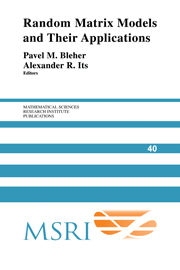Book contents
- Frontmatter
- Contents
- Preface
- Symmetrized Random Permutations
- Hankel Determinants as Fredholm Determinants
- Universality and Scaling of Zeros on Symplectic Manifolds
- z-Measures on Partitions, Robinson-Schensted-Knuth Correspondence, and β = 2 Random Matrix Ensembles
- Phase Transitions and Random Matrices
- Matrix Model Combinatorics: Applications to Folding and Coloring
- Interrelationships Between Orthogonal, Unitary and Symplectic Matrix Ensembles
- Dual Isomonodromic Tau Functions and Determinants of Integrable Fredholm Operators
- Functional Equations and Electrostatic Models for Orthogonal Polynomials
- Random Words, Toeplitz Determinants, and Integrable Systems I
- Random Permutations and the Discrete Bessel Kernel
- Solvable Matrix Models
- The τ-Function for Analytic Curves
- Integration over Angular Variables for Two Coupled Matrices
- Integrable Lattices: Random Matrices and Random Permutations
- SL(2) and z-Measures
- Some Matrix Integrals Related to Knots and Links
Phase Transitions and Random Matrices
Published online by Cambridge University Press: 25 June 2025
- Frontmatter
- Contents
- Preface
- Symmetrized Random Permutations
- Hankel Determinants as Fredholm Determinants
- Universality and Scaling of Zeros on Symplectic Manifolds
- z-Measures on Partitions, Robinson-Schensted-Knuth Correspondence, and β = 2 Random Matrix Ensembles
- Phase Transitions and Random Matrices
- Matrix Model Combinatorics: Applications to Folding and Coloring
- Interrelationships Between Orthogonal, Unitary and Symplectic Matrix Ensembles
- Dual Isomonodromic Tau Functions and Determinants of Integrable Fredholm Operators
- Functional Equations and Electrostatic Models for Orthogonal Polynomials
- Random Words, Toeplitz Determinants, and Integrable Systems I
- Random Permutations and the Discrete Bessel Kernel
- Solvable Matrix Models
- The τ-Function for Analytic Curves
- Integration over Angular Variables for Two Coupled Matrices
- Integrable Lattices: Random Matrices and Random Permutations
- SL(2) and z-Measures
- Some Matrix Integrals Related to Knots and Links
Summary
Phase transitions generically occur in random matrix models as the parameters in the joint probability distribution of the random variables are varied. They affect all main features of the theory and the interpretation of statistical models. In this paper a brief review of phase transitions in invariant ensembles is provided, with some comments to the singular values decomposition in complex non-hermitian ensembles.
1. Phase Transitions in Invariant Hermitian Ensembles
Random matrix ensembles have been extensively studied for several decades, since the early works of E. Wigner and F. Dyson, as effective mathematical reference models for the descriptions of statistical properties of the spectra of complex physical systems. In the past twenty years new applications spurned a large literature both in theoretical physics and among mathematicians. Several monographs review different sides of the physics literature of the past few decades, such as [7; 10; 18; 40; 41; 59; 92; 94]. Their combined bibliography, although very incomplete, exceeds a thousand papers. Sets of lecture notes are [102; 58; 5; 34; 85; 66]. The classic reference is Mehta's book [82].
For a long time studies and applications of random matrix theory in large part were limited to the choice of gaussian random variables for the independent entries of the random matrix. This was due both to the dominant role of the normal distribution in probability theory as well as to the nice analytic results which were obtained. Increasingly, in the past two decades, a wide variety of matrix ensembles were considered, where the joint probability distribution for the random entries depends on a number of parameters.
Information
- Type
- Chapter
- Information
- Random Matrix Models and their Applications , pp. 95 - 110Publisher: Cambridge University PressPrint publication year: 2001
Accessibility standard: Unknown
Why this information is here
This section outlines the accessibility features of this content - including support for screen readers, full keyboard navigation and high-contrast display options. This may not be relevant for you.Accessibility Information
- 1
- Cited by
